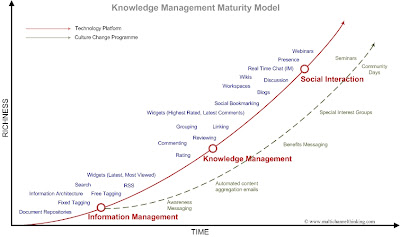One of the biggest problems facing most organisations is a combination of poor internal information sharing mechanisms and a lack of a collaboration culture. Since both are key foundations of innovation, this issue has serious consequences for organisational growth and success.
In my experience I've found that this problem is tackled one of two ways...
- Primarily through chucking technology at it - usually some kind of intranet with out of the box functionality, and
- Occasionally through culture change programmes.
There is often a belief amongst those implementing culture and business change that the change is technology independent. Conversely a lot of user experience professionals believe that behavioural issues can simply be addressed by making sure the interface and functionality of systems are compelling. Fact is that in this context, neither works without the other.
Driving highly collaborative and social sharing behaviours is pointless if the mechanisms for capturing and disseminating collective knowledge do not exist satisfactorily; and it is similarly pointless providing document sharing capability without a culture that encourages and rewards participating and interaction.
My advice is to develop and evolve your technology and culture together, with technology just preceding culture change activity in order to facilitate the human journey from hoarding documents and content, to sharing, to evolving it, to interacting socially around it.
I've created a 3 step Knowledge Management maturity model to show you how you might set this up for your business by increasing the richness of technological and social interaction over time.
- Information Management - The journey starts with Information Management through using fixed and free tags along with decent search capability to surface content. Fixed tagging helps structure content. Encouraging free tagging begins to make people feel they can interact with the content, which sets them up nicely for the next stage.
- Knowledge Management - Adding rating and commenting begins to allow qualitative evolution of information, which is essentially the core of knowledge management and also embeds the rudiments of inter-personal interaction around knowledge that facilitates off-line niche or special interest interaction.
- Social Interaction - Finally adding presence information and real time discussion (chat) capability combined with offline community days begins to drive widespread and cross-functional social interaction around information and knowledge sharing, which is really where you want to be as an organisation.
Hope it helps!
